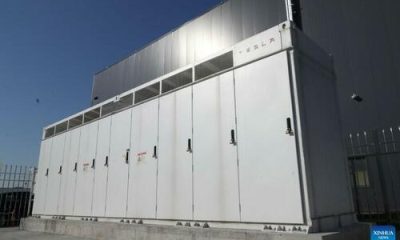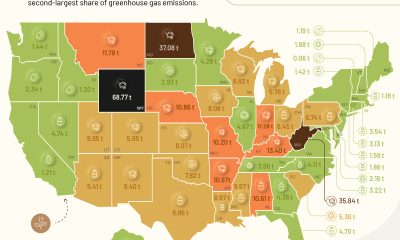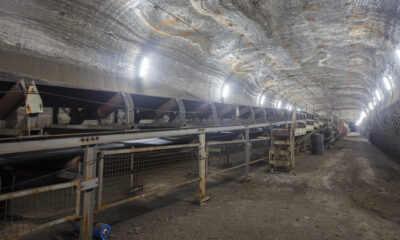Energy & Critical Metals
EU announces proposals to optimise energy storage
The European Commission has recommended ten points for EU Member States to exploit energy storage to its full potential.
The post EU announces proposals…

In the same breath as proposing electricity market reforms, the European Commission has recommended ten points for EU Member States to maximise energy storage to its full potential.
The Commission’s suggested reforms for Europe’s electricity design underline the fundamental role of flexibility that storage can provide to the electricity system.
In the document, the Commission recommends ten points for EU countries to consider when designing network charges and tariff schemes and facilitating permit granting.
Have you read:
Six uncomfortable truths about the energy transition
Netherlands set to get biggest ever battery storage system
According to their recommendations, Member States should:
- Account for the double role (generator-consumer) of storage when defining regulatory framework and procedures, in particular when implementing the Union legislation concerning the electricity market, in order to remove existing barriers. This includes preventing double taxation and facilitating permit-granting procedures.
- Identify the flexibility needs of their energy systems in the short, medium and long term, and in their updates of the national energy and climate plans strengthen the policies and measures that aim to promote demand response, flexibility and storage deployment, both utility-scale and behind-the-meter.
- Ensure that energy system operators further assess the flexibility needs of their energy systems when planning transmission and distribution networks, including the potential of energy storage (short- and long-duration) and whether energy storage can be a more cost effective alternative to grid investments. They should also consider the full potential of flexibility sources, in particular storage, when assessing their connection capacity (e.g. considering flexible connection contracts) and operating the system.
- Identify potential financing gaps for short-, medium- and long-term energy storage, including behind-the-meter (thermal and using electricity) and other flexibility instruments, and if a need for additional flexible resources to achieve security of supply and environmental objectives is identified, consider the potential need for financing instruments that provide visibility and predictability of revenues.
- Explore whether energy storage services – in particular the use of flexibility in distribution networks and the provision of non-frequency ancillary services – are sufficiently remunerated and whether operators can add up the remuneration of several services.
- Consider competitive bidding processes if necessary to reach a sufficient level of deployment of flexibility sources to achieve security of supply.
- Identify any specific actions, regulatory and non-regulatory, to remove barriers to the deployment of demand response and behind-the-meter storage, e.g. linked to the uptake of electrification of end use sectors based on renewable energy sources, the deployment of individual or collective self-consumption and to bidirectional charging through the use of electric vehicle batteries.
- Accelerate deployment of storage facilities and other flexibility tools in islands, remote areas and the EU’s outermost regions areas with insufficient grid capacity and unstable or long-distance connections to the main grid, for example through support schemes for low carbon flexible resources, including storage, and revise the network connection criteria to promote hybrid energy projects (i.e. renewable generation and storage).
- Publish detailed data on network congestion, renewable energy curtailment, market prices, renewable energy and GHG emission content in real time, as well as installed energy storage facilities, to facilitate investment decisions on new storage facilities.
- Support research and innovation in the technology, in particular long-term energy storage and storage solutions coupling electricity with other energy carriers, and to optimise existing solutions (e.g. efficiency, capacity, duration, minimal climate and environmental footprint). Consideration should be given to de-risking instruments, such as technology accelerator programmes and dedicated support schemes that guide innovative energy storage technologies through to the commercialisation stage.
EASE calls for energy storage integration in market reformations
The recommendations from the Commission coincided with their proposal for electricity market design reformation, a reformation that will form part of the Green Deal Industrial Plan. Key within the proposals was also the theme of flexibility, to which storage technologies can be leveraged.
In a press release response to the proposed market reformations, EASE – the European Association for Storage of Energy – called the upcoming revisions “an opportunity for the European Union to accelerate the transition to a sustainable and affordable energy system by boosting investment where it is most needed to achieve the Union’s Fit-for-55 and REPowerEU objectives.
“Energy storage must be deployed at a high speed and a large scale (2030 demand estimated at 200GW i.e. twice the current capacity) to offer cost-efficient solutions to increase the penetration of renewables in the system, contain electricity prices, and substitute fossil-based flexible generation while maintaining the security of supply.”
EASE’s response saw them join Cleantech for Europe, Climate Strategy, Future Cleantech Architects, 1.5° Ventures and InnoEnergy in urging co-legislators to use the potential of storage by introducing ambitious provisions.
Their recommendations to do so are twofold:
1. Strengthen the energy storage business case
According to EASE, the revised electricity market design must provide an appealing business case for projects to attract the necessary investment.
New market products, in particular for peak shaving, curtailment prevention and congestion management, will be needed to secure predictable revenue streams for storage, both utility-scale and behind-the-meter.
A lower carbon cap needs to be mandated in the capacity market and participation of carbon-neutral facilities should be favoured.
Energy Transitions Podcast: Europe’s urgent need for flexible balancing power
Support schemes need to be tailored to storage when market failures occur i.e. when the storage capacity deployed is not enough to ensure the flexibility needed in the system.
Storage needs to be a prime participant in the Power Purchase Agreement (PPA) market – a key focus area of the EU’s proposal – with a focus on 24/7 clean energy PPAs.
2. Further market visibility for projects should be provided with the following measures:
Energy storage targets need to be mandated at the Member State level, reflected in the 2030 NECPs (National Energy and Climate Plans), addressing flexibility needs from seconds to seasons.
Set the necessary conditions for a strong storage market. This includes signals for flexibility, harmonised capacity mechanisms and support schemes for storage facilities, as well as swift implementation of the new framework – all of which will play a key role in helping the European Union offer consumers a secure, sustainable, and affordable electricity supply.
The post EU announces proposals to optimise energy storage appeared first on Power Engineering International.

Uranium Exploration Company Announces Additional Staking in the Athabasca Basin
Source: Streetwise Reports 12/22/2023
Skyharbour Resources Ltd. announced an update from its Canada-based Falcon Project along with additional…
Tesla Launches New Mega Factory Project In Shanghai, Designed To Manufacture 10,000 Megapacks Per Year
Tesla Launches New Mega Factory Project In Shanghai, Designed To Manufacture 10,000 Megapacks Per Year
Tesla has launched a new mega factory…
Giving thanks and taking stock after “a remarkable year”
An end-of-year thank you to our readers, industry colleagues and advertisers before Electric Autonomy breaks from publishing until Jan. 2
The post Giving…














